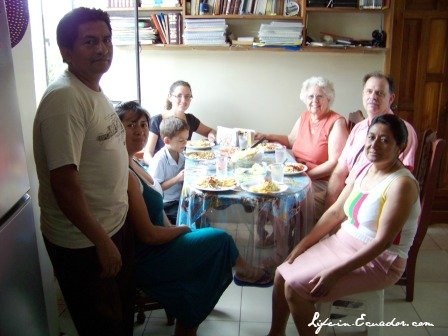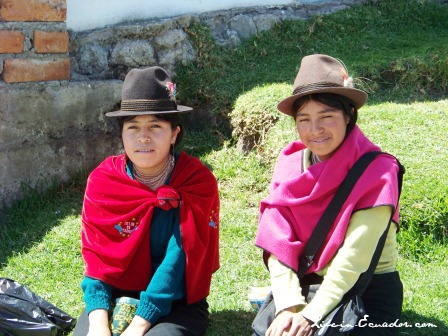My Ecuador Residency Experience
Part 2
Part One of my Ecuador residency experience went quite smoothly. But I had no idea what was in store for me when I got to Ecuador.
The lady that had been so helpful at the Consulate in the US gave me a list of what to do when I got to Ecuador. So they day after we got back, we got right to work.
The first stage of my Ecuador residency experience took place in the United States. To read Part One click here.
Note: If you don't want to read my entire experience, skip to the "Lessons Learned" in each step.
Step One-Register Temporary Visa
I entered Ecuador on a temporary six month visa. So the first step what to register this visa in Ecuador. This was my first encounter with the Dirección de Extranjería (Foreign Management Office) in Quito and it would be one of too many. Most of the Nonimmigrant (12) Visas require that you register your visa at the Dirección de Extranjería.
After finding the office, we had been told to speak directly to the manager and had his name. We were quickly informed that he was no longer manager, but that we could speak with the new manager.
She came down and we told her what we needed to do. She had to ask around to find out. Later, we realized that registering visas is one of the main tasks handled at the Dirección de Extranjería. So it was a little strange that she didn't know the process. Anyway....
We took a number for the person we needed to talk to only to find out that we needed to deposit $10 in a bank half way across town. So we ran to do this and get back in time to register the visa before the office closed at 4:30. We made it back, but we were getting very annoyed at the customer service.
Many were waiting patiently, even whole groups coming to volunteer or go to school. Then we would see a spiffed up businessman come in and go straight to the person he wanted to talk to. No number. The people working seemed happy to help; I wouldn't be surprised if there was some money being passed under the table.
We started to fuss a bit, but it did no good. I finally filed a written complaint, which I like to think has helped to some extent because the cutting in line seems to be less now.
Once we had the visa filed, I had to get a censo which is an identification card for foreigners. It is quite easy to get at any Immigration (Migración) office in Ecuador. You have to bring a copy of your passport and visa. Plus a recent photo. The fee was $5 in Tena and $4 in Quito. (Note: The censo is no longer required.)
Lessons learned:
- Go to the information desk straight away if you are dealing with the Direcciónde Extranjería for the first time. They will make sure you get a number for the right person. They can also make sure you have the necessary paperwork and payment receipts for your transaction.
- Be ready to wait. I now plan on at least 2 hours each time I come.
- It's better to file a written complaint than to verbally complain. It just seems to make them work slower if you start to get angry. Plus the more of us that complain in writing....who knows maybe things will get better.
- The Dirección de Extranjería is open from 8:30 a.m. to 4:30 p.m. If you go early it's possible to get in quickly. Don't even bother to go after about 2:00 p.m. You could end up waiting only to be kicked out at 4:30 p.m. with nothing to show for the time you waited. The lunch hour (12:00 until 2:00 p.m.) can be problematic as well. No replacements are available while workers go to lunch. And they go for as long as they want.
Step 2-Filing for Ecuador Residency
Once my visa was registered, I asked for the information I needed to file for my Ecuador residency visa. It was pretty straightforward. You can find the information at the Ministry of the Interior's website and download the forms you will need. (The website is being updated and you may find a lot of broken links. If the website is down or you cannot find the info you need, just ask at the information desk and the Direccion de Extranjeria.)
I was applying for the 9-VI visa which is based on the dual citizenship of my son. So we were quite sure we would not be denied the visa.
There were a few forms to fill out and notarized copies of passports, birth certificates, marriage certificates ect. to get together. But I wasn't too worried, because the information said to file at least 30 days before your current visa expires. I had six months, so I was in no rush.
Note: As of 2017, you can no longer base your residency on your Ecuadorian children. A spouse can sponsor his/her mate and parents can sponsor their children. No other family members seem to qualify as in the past.
The one part that was difficult was the letter you have to write demonstrating your right to Ecuador residency and asking that it be granted. The letter must include the laws you base your request on. These laws are mentioned in the instructions we had, but we didn't realize they have to be in the letter as well.
We tried our best to write a letter that satisfied the requirements set out in the instructions, but it was not accepted. I was flustered because I am not fluent in technical, lawyer Spanish so I wasn't going to be able to make it any more formal.
As we walked out, a man approached wondering if we needed photos or copies. And when he heard we needed the letter he sent us to a woman just around the corner (from the former Dirección de Extranjería office). She was a lawyer and in less than 15 minutes wrote up a letter that was accepted by the Dirección de Extranjería. She charged us $5.
Thankfully your paperwork is checked and double checked before filing. So it shouldn't happen that you file your paperwork and find out later that you forgot something.
Lessons learned:
- Ask for the list of requirements or download them. Don't even attempt to file until you have everything. Each immigration office has leeway to ask for documents in addition to those listed online.
- Your petition requires contact information. Don't expect to ever hear from the Dirección de Extranjería. You have to continually go and check if your petition has been approved.
- Get help writing the petition letter. It will be worth the money to get it right and to get it done with.
Step 3-Petition Approved!
I was told to return after a month to see if my visa was approved. Knowing how things are in Ecuador, I let two extra weeks go by. Just wanted to be sure it would be done.
When I went to check, I asked at the information desk. The lady asked to see my receipt which had my case number on it. As soon as she saw the date she shook her head. "Sorry we are still finishing up the petitions from last year. Come back in two weeks." Ok this was in March. And they still weren't done with last year?!? I asked for reassurance that the visa would be done if I came in a month and she said yes.
Again, I added two more weeks to the two weeks and went back. This time I was told that my visa was approved, but that there was no one to sign the visa. The current supervisor had been fired and they were hoping to have a replacement in two weeks. They had me pay for my visa ($50) and told me to come back in two weeks.
Two weeks seems to be the going wait time; they seem to tell everyone two weeks.
I went back three weeks later. This time a state of emergency had been declared. Besides having a brand new supervisor in charge they were in the process of moving the offices across town. So there was a crowd of people outside ready to start a riot. A security guard was outside giving out numbers and organizing the people into lines to wait. No one was allowed inside until it was their turn.
A lady in my line asked me what I was doing and I told her. She looked at my number and said that I had been given the wrong number and was in the wrong line. I had seen this same security guard give out the wrong numbers several times before, but I decided to stay in my line and see what happened.
My little boy started banging the windows out of impatience. The guard came to ask him to stop and all the people around me started yelling..."What do you expect. He's a little kid and who knows how long they will have to wait." The guard took me inside and had me waited on right away. By this time I was getting a little stressed.
The lady asked me what I needed and I started crying. She tried to explain to me that getting a visa to go to my country was just as hard.
Whoa! Wait! I've already seen the visa process in the U.S. Yes it takes a long time (2 years in my husband's case), but you wait at home. And you aren't told to travel six hours on the bus every two weeks only to be told to come back in two more.
When the lady realized I was coming all the way from Tena, she went to find my paperwork. All it needed was the signature.
All this time they had my passport. So if I had had any emergency and needed to leave I would've been in trouble.
My passport was taken to the supervisor and after another 2 hours of waiting I had my passport in hand, stamped with my permanent residency visa.
Lessons learned:
- File your paperwork as soon as possible. You don't want the extra headache of extending your temporary visa. My total wait time was about 4 months.
- Be persistent. The squeaky wheel gets the oil, right? Crying seems to help. ;)
- If you aren't feeling up to this test of patience, you may want to consider hiring a lawyer. A lawyer is not necessary, but if you do hire one they are the ones that make all these trips to the Dirección de Extranjería. And you may feel the fee they charge is worth it just to avoid the stress.
- Do not lose your receipt. Write the case number down or memorize it in case you do.
Step 4-Ecuadorian ID
Finally, I have my permanent Ecuador residency. The last step was to acquire Ecuadorian ID. The Ecuadorians carry and ID Card called a "cédula." As a resident in Ecuador, I also have to carry this card.
So after having my visa approved, I was told to get a new censo (the ID for foreigners) showing my resident status. And after two weeks come back to Quito to get my cédula.
Thinking it would be less of a wait in Tena we went there to get the censo. It was quick and painless.
When I got to Quito for the cédula there was a problem. The censo did not show my name exactly the way the paperwork from the Dirección de Extranjería did (with two last names).
We spent three weeks trying to get this changed in Tena. Finally the policeman at Migración in Tena said he didn't know what else to do. He was unable to change my name or get Quito to change it in their system.
So we went to Migración in Quito. In literally 15 minutes, it was all changed and I was waiting my turn to get the new censo.
With copies of this new censo, my passport and visa we went back to the Civil Registry in Quito for the cedula. Everything was okayed and we were set to get the cedula. When my turn came for the cedula, another problem...
My city of birth was not in the system. When my son got his cedula his city of birth was not in the system either. So we had to wait until the next day for the city to be added and then the cedula was processed.
Being a first time cedula for a foreigner, I would not be able to get it until the next afternoon. We needed to go back to Tena before then, so I just got the cedula the other day. Total time from start to finish....we got here in January, and now in August I have everything settled.
Lessons learned:
- Make sure your name is correct on the paperwork you are given from the Dirección de Extranjería. Quito is probably the best place to get this done. It was quick and easy.
- Once your paperwork is approved at the Civil Registry in Quito for your cedula go to Supervisión or Información. Have them check that your city of birth is in the system before you wait hours only to find out it isn't. I'm not 100% they will check this for you, but it's worth asking. If you were born in a major city like LA or NYC you shouldn't have to worry about this.
In the end...
Now that it's all said and done...what a relief! I hope to never have to go to the Dirección de Extranjería again, although that's probably just wishful thinking. I try not to dwell on the stress of it all because I am glad to be able to be in Ecuador now for as long as I want.
Good to know: Once you have your Ecuador residency you can not leave the country for more than 90 days for each of the first two years. After the two years you can come and go as you wish, as long as you return to Ecuador at least every 18 months.
You may also enjoy these pages...
 Getting along with others in Ecuador, or... Getting along with others in Ecuador, or... |
 Ecuador People Ecuador People |
Home › Ecuador Visa › Ecuador Residency Experience Part 2





Comments
Have your say about what you just read! Leave me a comment in the box below.